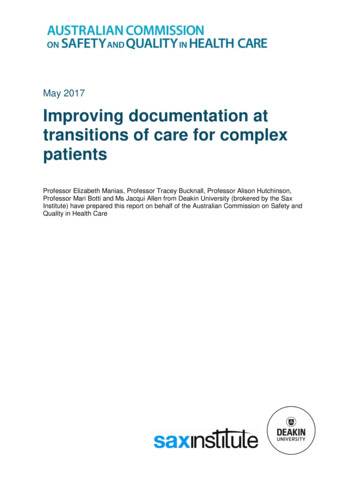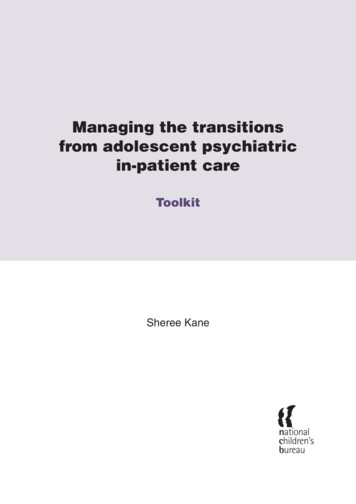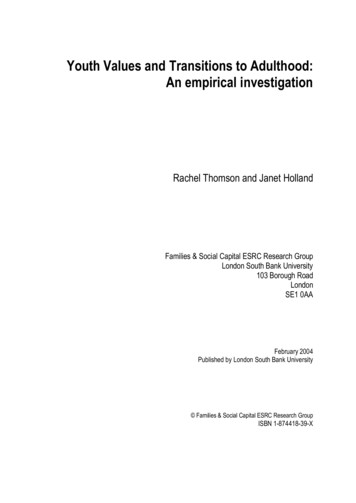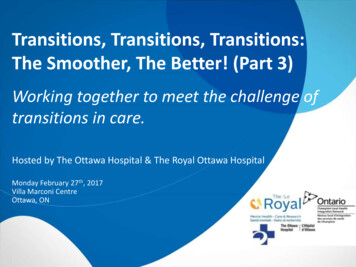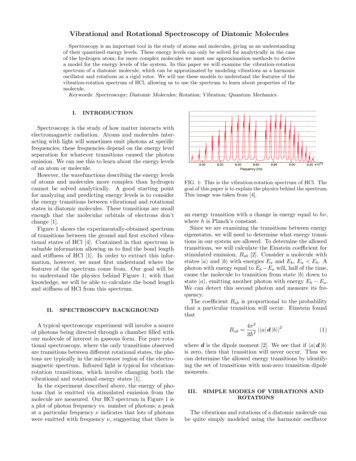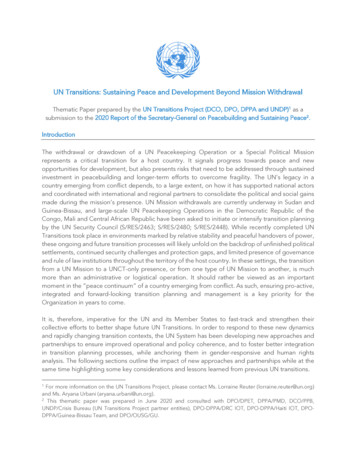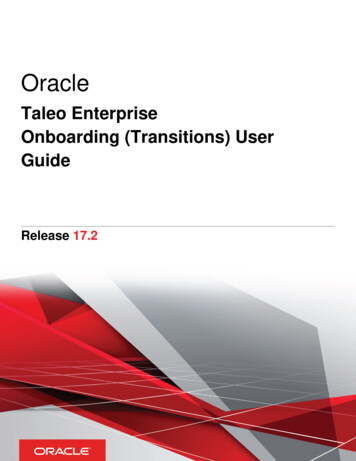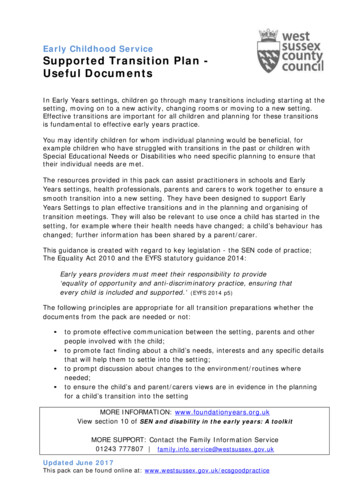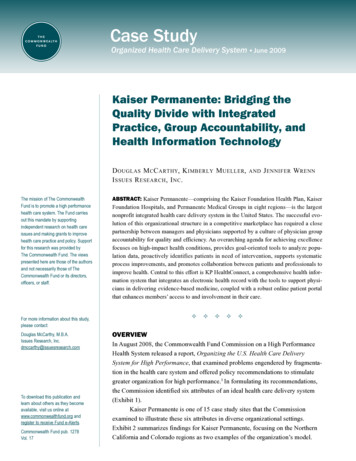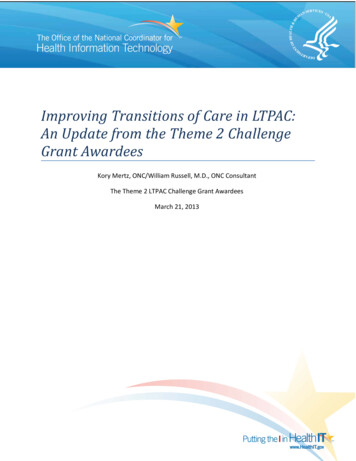
Transcription
Improving Transitions of Care in LTPAC:An Update from the Theme 2 ChallengeGrant AwardeesKory Mertz, ONC/William Russell, M.D., ONC ConsultantThe Theme 2 LTPAC Challenge Grant AwardeesMarch 21, 2013
OverviewIn February, 2011, The Office of the National Coordinator for Health Information Technology(ONC) awarded ten Challenge Grants intended “to encourage breakthrough innovations forhealth information exchange (HIE) that can be leveraged widely to support nationwide healthinformation exchange and interoperability.” 1 Four State HIE Cooperative Agreement Programgrantees (Colorado, Maryland, Massachusetts, and Oklahoma) were each awardedapproximately 1.7 million to improve long-term and post-acute care (LTPAC) transitions.Collaboratively, the grantees have identified strategies and approaches that can be widelyadopted by communities seeking to improve transitions of care to and from LTPAC providers: Common processes and appropriate connection points for clinical information transferbetween hospitals and LTPAC providersRecommendations for hospital and LTPAC provider data needsStrategies to promote the use of standards based technology to create, transmit andview clinical documents of relevance to LTPACApproaches to engage LTPAC providers where they are today across the health ITadoption spectrum (from high adoption to no adoption)In addition, the grantees have encountered challenges that will need to be addressed by anycommunity seeking to address this issue: Uneven adoption of non-certified electronic health records makes connections betweenacute and post acute care providers challenging and labor intensiveHigh staff turnover rates create implementation and ongoing operational challengesCommon Lessons:Each of the Challenge Grants has attempted to define, and when possible, address barriers todata exchange to and from LTPAC during transitions of care. A number of common themeshave -programPage 2
(a) Heterogeneous Technology AdoptionThe Challenge Grantees have found heterogeneous technology adoption rates and levels acrossLTPAC settings. There is widespread adoption of electronic systems to create and transmitfederally required assessments for payment and quality reporting with more variable adoptionof other electronic systems.To address these conditions the grantees have actively worked to meet providers where theyare today in the health IT adoption spectrum. The grantees are working to integrate health ITenabled facilities into health information organziations including providing data feeds to theexchange and enabling secure messaging. For low or no technology adopted facilities granteesare experimenting with various approaches including implementing web based portals toenable secure messaging with trading partners, providing simple tools for clinicaldocumentation to facilitate the electronic capture of LTPAC data that can then be shared attransitions and providing access to web based portals to query hospital information.Grantee Case Study:Oklahoma worked diligently to ensure that all five nursing homes participating in their projecthad the infrastructure in place to exchange electronic information—even to the extent ofneeding to install T1 lines across the five nursing homes. They went through an extensiveprocess with the facilities to select the best solution for staff to interact with the clinicaldocumentation tool (computer terminals, mobile station, wall mounted kiosks etc) and basedon conversations and workflow analysis decided upon wall mounted kiosks. One key driverbehind this decision was a desire to have a wired connection to the internet. Theimplementation team had experience with failures of wireless systems in hospital settings andthe lack of onsite support in the nursing homes prompted the team to select a hard wired kioskbased device for access to the application.Massachusetts is meeting LTPAC providers where they are by providing LAND (“Local” Adaptorfor Network Distribution) and SEE (Surrogate EHR Environment). LAND allows organizationswith fully implemented electronic records capable of generating the newly specified transitionof care and care plan data elements, to create, transmit and receive these new documenttypes. SEE, intended for organizations without the ability to create these documents, allowsproviders to view, edit, and send these documents to the receiving facility via Direct messagetransmission from a web browser.Colorado and Maryland are working with some highly adopted LTPAC facilities to directlyintegrate their EHRs into the existing state exchange.Page 3
In facilities with electronic health record (EHR) systems, grantees have found healthinformation exchange connectivity is generally not an integral component of the products.Connecting these EHRs to the exchange often required one-off solutions. As new payment anddelivery models are being implemented incentives are changing and the imperative for LTPACconnectivity is increasing and a number of leading vendors are actively working to increasetheir exchange and interoperability capabilities, however this progress is generally slow anduneven. Since 2011 the number of LTPAC vendors seeking Certification Commission for HealthInformation Technology certification for LTPAC and ONC modular certification has increased.The Center for Aging Services Technologies is now tracking certification on their EHR vendorselection analysis grid for LTPAC providers.(b) StandardsMassachusetts has done extensive work through their project to identify the relevant dataneeds of LTPAC providers and support the development of a standardized way to capture thesedata elements. To start, Massachusetts completed a multidisciplinary survey of “receivers” 2across the continuum of care in an effort to understand their data needs. IMPACT used theMassachusetts Universal Transform Form and evaluated the practicality and clinical relevanceof expanded datasets as specified by the receivers of that data. Overall, 169 unique transitionsof care were identified and analyzed, from this work. Through review they narrowed this downinto five Transition of Care data sets that could meet the needs of nearly all the types oftransitions. You can view the Transitions of Care full data set here. The data sets were thentested via a paper and or technology based care transition process with the participating pilotsites. Over 90% of receivers reported that the specified data was provided during a transitionand a similar number of senders reported success in populating this more robust transition ofcare document.Massachusetts is now developing an implementation guide for expressing the five transitiondata sets as CDA documents. These will be used in both the LAND and SEE implementations.Massachusetts is actively collaborating with the Standards and Interoperability Framework’sLongitudinal Coordination of Care Workgroup.2Receiver types surveyed included: integrated delivery networks, a Federally Qualified Health Center, a largeindependent multispecialty group practice, a long-term acute care facility, an inpatient rehabilitation facility, homehealth and hospice agencies, and skilled nursing and extended care facilities.Page 4
(c) Workflow and Clinical ProcessToday transition of care information exchange predominately occurs on paper or via fax inLTPAC facilities. The Challenge Grantees have been actively working with their pilot sites tomap out new workflow and clinical process that use electronic solutions to send and receive theneeded transitions of care information.LTPAC facilities have unique processes for collecting and distributing clinical documents. This isbased on their internal process for clinical review of prospective clients. Factors such as acuity,service needs, and staffing levels usually means that an administrator and a nursing leaderalong with the medical director, who is typically not on site, may all need access to information.Challenge Grantees have focused on using information to improve clinical workflow anddecision-making.In Colorado, referrals from hospitals to LTPAC providers are being routinely augmented by datacollected within the HIE. This additional source of data allows the receiving organization toapprove admissions more quickly, and to triage resources more effectively. This allows HomeHealth Agencies to meet their “start of care” timing requirements more effectively. In addition,LTPAC providers, including Home Health Agencies and Nursing Facilities, have found that datafrom multiple episodes of care and multiple institutions allows them to identify patients whohave particularly high resource utilization patterns and medical complexity. By getting a morecomplete clinical picture of the patients, providers are able to ensure that an appropriate levelof service and strategies to prevent readmissions are introduced promptly.In Oklahoma, HIE is changing the way urgent evaluations of patients are informed. In the past,patients with a change in condition in a nursing facility were managed by nurses withtelephonic support by an off-site attending medical provider. If the problem resulted in a needfor a transfer to an emergency department (ED), the patient would be accompanied bywhatever paper documentation could be created and handed to the emergency medicaltechnicians for delivery to the ED. Patients from nursing facilities who appeared in ED’s withlimited documentation and cryptic symptoms were often admitted to the hospital.To address this, Oklahoma is utilizing DIRECT to send a secure message to the hospital withchange in condition documentation when a patient is transferred to an ED. Providing importantclinical information earlier in the care episode assures that the medical provider is engagedreliably and with more complete data, thereby allowing the provider to contribute to the careof the patient and potentially avoid the need for ED utilization. If the need does arise, however,the HIE now allows a set of clinical documents detailing the symptoms and events leading up tothe transfer to be available to the receiving facility. It also provides the capacity tocommunicate assessments performed in the ED to both the nursing facility and the attendingPage 5
medical provider, creating the opportunity to safely transition the patient back to the sendingfacility when appropriate.(d) Staffing and User AccessMany different types of staff are being given access to the health information technology toolsin LTPAC facilities including administrator, clinical liaison, nurse, call center staff, director ofnursing, directors of admission, director of social service, intake coordinator, admissioncoordinator and IT directors. In Colorado, for instance, they are finding success with providingaccess to 2-3 core users: the intake coordinator, admission coordinator, IT director or directorof nursing. These core users play a pivotal role in sharing information with other staff asneeded. Oklahoma gives access to a core team that usually is comprised of the administrator,director of nursing, assistant director of nursing, compliance leader and senior charge nurse. Incontrast, Massachusetts nursing facilities plan to use case managers or nursing coordinators toassemble data to be sent at transitions and in home health they will rely on call center staff.When Colorado started their work with LTPAC facilities they utilized multiple project managersand implementation managers to onboard the facilities. After testing this approach for a timeand finding that LTPAC facilities had unique onboarding needs, Colorado decided to hire asingle staff person to work with LTPAC facilities. This allowed the individual to become anexpert on the training, scheduling and implementation needs of LTPAC facilities.The high staff turnover rates in some LTPAC facilities have created challenges engaging facilitiesand training staff on the use of health information technology interventions. Colorado hasaddressed this by training multiple staff in each facility. Oklahoma was very intentional in itsengagement strategies to work with very small user groups in well-defined phases.“Software implementation in healthcare always has a number of moving parts withintegrated workflows and complex reasoning which often the organization struggles todefine. Despite the most rigorous process analysis of the organization, many workflowsand processes are unknown until they are actually forced to change. It was understoodthat the LTC facilities would be facing a dramatic process change and from anorganizational leadership standpoint they were not equipped to address. The key benefitof doing our program in phases was that it gave a chance to conduct process evaluationearly without overwhelming our team and more importantly the facilities. This processmade it a lot easier to respond back to feedback and make any necessary adjustments toimprove our program.”Matt Cairns, Project Manager, Oklahoma Challenge Grant.Page 6
(e) Value PropositionGiven the low engagement to date of LTPAC providers in health information exchange theevidence for return on investment in terms of improved clinical care, greater efficiency orreduced readmissions is limited. The availability of electronic systems at some sites haveallowed receivers to view and download clinical documents through portals or virtual privatenetwork (VPN) tunnels. These documents include those required to evaluate referred patientsfor admission, as well as summaries required for inclusion in the facility medical record as aMedicare condition of participation. Examples include dictated discharge notes, and documentsand data required to complete Federally-required assessments such as the OASIS instrumentfor home care.Early Grantee experiences include: Increased interest from LTPAC providers in participating in the electronic exchange ofhealth information due to changing incentives from the hospital readmission penaltiesand payment and care delivery reforms.Reduced staff time to acquire information needed to populate Federally requiredassessments.Reuse of clinical data captured electronically (e.g. from OASIS, MDS or INTERACT forms)has resulted in workflow efficiencies compared to prior paper processes.For providers that haven’t adopted an EHR, the ability to send and receive theinformation electronically vs. fax has been very favorable due to reducing the cost of faxsupplies and the staff time to pull faxes.More complete data reduces the burden on patients and families associated withreporting basic information to clinical staff.The Challenge Grantees have reported various stories 3 that demonstrate the value of healthinformation exchange for LTPAC providers. Improved, more accurate and timely medication reconciliation.Home care agencies coordinating anticoagulation for patients now have instant accessto the full panel of results for patients thereby reducing errors and gaps in treatmentassociated with delays in results reporting.Common problems such as missed wound care treatments or therapy visits for frail andvulnerable patients have been e-health-providersconnect-to-hie-(1).aspxPage 7
Grantee Project Summaries(a) Colorado:Colorado Regional Health Information Organization (CORHIO) is working with LTPACorganizations, including home health, hospice, skilled nursing, assisted living and long-termacute care hospitals to improve care transitions to and from acute care settings through HIE.The goals of the program are to facilitate adoption of CORHIO’s HIE product by the LTPACcommunity, develop a community protocol for information sharing across care transitions,ensure all LTPAC providers have the capacity to share health information with patients uponrequest and measure the impact of HIE on quality of patient care and rates of hospitalreadmissions.In four diverse Colorado communities (Boulder County, Colorado Springs, Pueblo/Canon Cityand the San Luis Valley), CORHIO is working with LTPAC organizations to demonstrate the valueof participating with the rest of the local and statewide health care community in improvinginformation sharing and care coordination through HIE. This community approach to providecare, strengthened by fostering collaborative relationships between key providers, including the29 hospitals connected to CORHIO, the 600 physician practices, labs and behavioral healthfacilities, has encouraged the adoption of HIE. CORHIO identified 300 LTPAC providers in thetargeted communities, with a goal of 80 participating in HIE by January 2014. As of March,CORHIO has signed participation agreements that cover 78 LTPAC facilities of which 37 werelive. CORHIO is actively reaching out to additional LTPAC providers and utilizing ChallengeGrant funding to help encourage their participation in community-based HIE and in the LTPACTransitions program.For more information see 012.pdf(b) Maryland:Maryland is leveraging the operational statewide HIE to electronically share critical pieces ofclinical information, including information on advance directives, in near real-time as residentsof the state’s LTPAC facilities transition from one care setting to another. The project has threecomponents. The first is to onboard six LTPAC facilities with high health IT adoption to thestatewide HIE, Chesapeake Regional Information System for Our Patients (CRISP). Caretransitions among these facilities and five geographically proximate hospitals, which are alsolive on CRISP, are then being observed to evaluate the impact of the HIE. The technologycomponents of the project include integration of the LTPAC facilities’ EHR demographic (admitdischarge-transfer, or ADT) and clinical data.Page 8
The second component of the pilot project is focused on making clinical discharge dataavailable to LTPAC facilities that have not adopted an EHR system, using a secure Web-basedportal. At the end of the hospitalization for a patient who has been identified as a LTPAC facilityresident, discharge summary data is published to the HIE, where it may be searched for andviewed by the home LTPAC facility.The third component of the pilot project calls for Maryland to plan and test the availability ofan electronic registry of Medical Orders for Life Sustaining Treatment (MOLST) forms. TheMaryland team convened a multi-stakeholder workgroup which included representatives fromthe LTPAC community in addition to hospitals, technologists, and state policymakers. Theworkgroup developed recommendations to not only share advance directives using thestatewide HIE but also to create an electronic registry of MOLST forms.The progress to date in Maryland suggests that some reconceptualization of the work effort isrequired to make efficient use of the remaining funding and to achieve the components in thescope of work. In particular, the progress in implementing the EHR integration component hasbeen mixed, with challenges to reengineering existing workflows, development of interfaceswith EHR vendors and timing challenges due to participants switching EHR systems. Tomaximize progress the Maryland team is reallocating some of the remaining funding from theintegration component to other LTPACs that will utilize CRISP’s HIE services to improve caretransitions.For more information see 02.pdf(c) Massachusetts:The Improving Massachusetts Post-Acute Care Transfers (IMPACT) project is developing aninnovative and replicable model that will improve care transitions to and from post-acute caresettings. Over the past year, the project has focused on extending existing health IT standardsto better meet the data needs of LTPAC providers and creating health IT tools that will enableboth EHR adopted and un-adopted LTPAC facilities to participate in standards based exchange.The IMPACT project has six objectives: (1) Enable all LTPAC organizations, including nursing andrehab facilities, and home health agencies to participate in regional and statewide HIE; (2)Improve the speed, efficiency, and satisfaction of processes to provide essential clinical dataduring transitions of care; (3) Decrease avoidable ED visits, hospital admissions, and hospitalreadmissions; (4) Reduce unnecessary tests and treatments; (5) Reduce the total cost of care;and (6) Replicate this model in other communities.Page 9
To achieve these six objectives, the project has adopted the following five strategies: (1) Finishdefinition and testing of data elements required for LTPAC transitions of care, based onMassachusetts Department of Public Health’s multi-stakeholder-developed paper universaltransfer form (UTF). This work was expanded to meet the needs of behavioral health,community based service providers, EDs, in-patient floors, out-patient treatment and testareas as well as all LTPAC providers; (2) Update and ballot through a national consensusprocess, HL7’s Consolidated CDA Implementation Guide to support these data elements; (3)Develop reusable software applications to acquire/view/reconcile/edit/send these extendedConsolidated CDA documents using Direct (LAND & SEE); (4) Integrate these tools across thecontinuum of care in Worcester County; and (5) Measure outcomes.For more information see 12/05/MATheme-2-Challenge-Grantee-Summary.pdf(d) Oklahoma:Oklahoma is working with five nursing homes, a referring hospital and an established regionalhealth information exchange to implement key interventions to improve transitions. They arefocused on improving information transfer in the patient’s transition to and from nursinghomes and an emergency department. The nursing homes have implemented a clinicaldocumentation tool that includes the collection of change in condition documentation. At thetime of a transition a “need to know message”, based on a nursing document referred to as“SBAR” (Situation/Background/Assessment/Recommendation), will be sent via Direct from thenursing home to the hospital. This will provide the immediate information the ED needs. Oncecompleted a universal transfer document will follow providing a more complete account of thepatient. The hospital will also be able to query the regional HIE for information on the patient.A similar information flow will be able to follow the patient back to the nursing home upondischarge from the hospital.Oklahoma expects that sharing more information during encounters in the ED could result inreduced acute hospital admissions and more thorough evaluations resulting in safe return tothe LTPAC setting with expanded care plans based on the ED evaluation. In addition to theimplementation of the technology to support electronic exchange of patient-specificinformation, Oklahoma is focusing on improving the workflow and processes associated withcare transitions to ensure effective use of information to improve patient care.For more information see 2/06/Challenge-Grantee-Summary-Oklahoma V4-2.pdfPage 10
ConclusionDifferences in clinical processes, skillsets, staffing turnover, degrees of technology adoption,information needs, interoperability capacity and standards, and a lack of standardized roles andprocesses all pose unique challenges to the successful effectuation of fully informed transitionsof care between hospitals and LTPAC settings. The Challenge Grantees are actively identifyingsolutions to the challenges facing LTPAC providers in participating in health informationexchange. They have identified the information needs of LTPAC providers, critical connectionpoints for sending and receiving information, use cases for exchange and opportunities forstandardization of content for clinical summaries and other documents of clinical utility.Engaging LTPAC providers in HIE will be important to achieving care improvement goals andreducing hospital readmissions. Secure messaging holds significant potential for engagingLTPAC providers in exchange, improving the privacy of clinical communication in LTPAC andstreamlining the distribution of documents.This mid-point check in with the LTPAC Challenge Grantees provides a number of valuableinsights from their early implementation efforts. In 2013, the Challenge Grantees will have fullyimplemented their solutions and will provide the community insights and metrics related towhich health information exchange related interventions make the biggest difference forpatient outcomes in LTPAC settings.Page 11
Appendix 1: Challenge Grant AwardeesState/SDE RecipientState HIE CooperativeAgreement Award2011 HIE Challenge GrantSupplement AmountChallengeThemeNorth Carolina Departmentof State Treasurer 12,950,860.00 1,708,693.001Colorado Regional HealthInformation Organization 9,175,777.00 1,718,783.002Massachusetts TechnologyPark Corporation 10,599,719.00 1,717,610.002Maryland Department ofHealth & Mental Hygiene 9,313,924.00 1,683,171.002Oklahoma Health CareAuthority 8,883,741.00 1,719,086.002Georgia Department ofCommunity Health 13,003,003.00 1,686,989.003Indiana Health InformationTechnology, Inc. 10,300,000.00 1,267,970.003Indiana Health InformationTechnology, Inc. 10,300,000.00 1,718,439.004Massachusetts TechnologyPark Corporation 10,599,719.00 1,675,019.005 5,767,926.00 1,400,802.005HealthShare MontanaPage 12
contrast, Massachusetts nursing facilities plan to use case managers or nursing coordinators to assemble data to be sent at transitions and in home health they will rely on call center staff. When Colorado started their work with LTPAC facilities they utilized multiple project managers and implementation managers to onboard the facilities.

